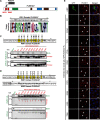Cooperative binding of the tandem WW domains of PLEKHA7 to PDZD11 promotes conformation-dependent interaction with tetraspanin 33
- PMID: 32371390
- PMCID: PMC7363125
- DOI: 10.1074/jbc.RA120.012987
Cooperative binding of the tandem WW domains of PLEKHA7 to PDZD11 promotes conformation-dependent interaction with tetraspanin 33
Abstract
Pleckstrin homology domain-containing A7 (PLEKHA7) is a cytoplasmic protein at adherens junctions that has been implicated in hypertension, glaucoma, and responses to Staphylococcus aureus α-toxin. Complex formation between PLEKHA7, PDZ domain-containing 11 (PDZD11), tetraspanin 33, and the α-toxin receptor ADAM metallopeptidase domain 10 (ADAM10) promotes junctional clustering of ADAM10 and α-toxin-mediated pore formation. However, how the N-terminal region of PDZD11 interacts with the N-terminal tandem WW domains of PLEKHA7 and how this interaction promotes tetraspanin 33 binding to the WW1 domain is unclear. Here, we used site-directed mutagenesis, glutathione S-transferase pulldown experiments, immunofluorescence, molecular modeling, and docking experiments to characterize the mechanisms driving these interactions. We found that Asp-30 of WW1 and His-75 of WW2 interact through a hydrogen bond and, together with Thr-35 of WW1, form a binding pocket that accommodates a polyproline stretch within the N-terminal PDZD11 region. By strengthening the interactions of the ternary complex, the WW2 domain stabilized the WW1 domain and cooperatively promoted the interaction with PDZD11. Modeling results indicated that, in turn, PDZD11 binding induces a conformational rearrangement, which strengthens the ternary complex, and contributes to enlarging a "hydrophobic hot spot" region on the WW1 domain. The last two lipophilic residues of tetraspanin 33, Trp-283 and Tyr-282, were required for its interaction with PLEKHA7. Docking of the tetraspanin 33 C terminus revealed that it fits into the hydrophobic hot spot region of the accessible surface of WW1. We conclude that communication between the two tandem WW domains of PLEKHA7 and the PLEKHA7-PDZD11 interaction modulate the ligand-binding properties of PLEKHA7.
Keywords: ADAM metallopeptidase domain 10 (ADAM10); PDZ domain containing 11 (PDZD11); PDZD11; PLEKHA7; Pleckstrin homology domain containing A7 (PLEKHA7); WW domain; adherens junction; cell-cell junction; cooperativity; membrane protein; molecular docking; polyproline; protein complex; tetraspanin 33; tetraspanin33; α-toxin.
© 2020 Rouaud et al.
Conflict of interest statement
Conflict of interest—The authors declare that they have no conflict of interest with the contents of this article.
Figures




Similar articles
-
PLEKHA7 Recruits PDZD11 to Adherens Junctions to Stabilize Nectins.J Biol Chem. 2016 May 20;291(21):11016-29. doi: 10.1074/jbc.M115.712935. Epub 2016 Apr 4. J Biol Chem. 2016. PMID: 27044745 Free PMC article.
-
A Dock-and-Lock Mechanism Clusters ADAM10 at Cell-Cell Junctions to Promote α-Toxin Cytotoxicity.Cell Rep. 2018 Nov 20;25(8):2132-2147.e7. doi: 10.1016/j.celrep.2018.10.088. Cell Rep. 2018. PMID: 30463011
-
WW, PH and C-Terminal Domains Cooperate to Direct the Subcellular Localizations of PLEKHA5, PLEKHA6 and PLEKHA7.Front Cell Dev Biol. 2021 Sep 9;9:729444. doi: 10.3389/fcell.2021.729444. eCollection 2021. Front Cell Dev Biol. 2021. PMID: 34568338 Free PMC article.
-
PLEKHA7: Cytoskeletal adaptor protein at center stage in junctional organization and signaling.Int J Biochem Cell Biol. 2016 Jun;75:112-6. doi: 10.1016/j.biocel.2016.04.001. Epub 2016 Apr 9. Int J Biochem Cell Biol. 2016. PMID: 27072621 Review.
-
Structural insights into the functional versatility of WW domain-containing oxidoreductase tumor suppressor.Exp Biol Med (Maywood). 2015 Mar;240(3):361-74. doi: 10.1177/1535370214561586. Epub 2015 Feb 7. Exp Biol Med (Maywood). 2015. PMID: 25662954 Free PMC article. Review.
Cited by
-
Identification of PDZD11 as a Potential Biomarker Associated with Immune Infiltration for Diagnosis and Prognosis in Epithelial Ovarian Cancer.Int J Gen Med. 2024 May 14;17:2113-2128. doi: 10.2147/IJGM.S459418. eCollection 2024. Int J Gen Med. 2024. PMID: 38766598 Free PMC article.
-
Evaluation of PDZD11 in hepatocellular carcinoma: prognostic value and diagnostic potential in combination with AFP.Front Oncol. 2025 Mar 25;15:1533865. doi: 10.3389/fonc.2025.1533865. eCollection 2025. Front Oncol. 2025. PMID: 40201341 Free PMC article.
-
Intramolecular autoinhibition regulates the selectivity of PRPF40A tandem WW domains for proline-rich motifs.Nat Commun. 2024 May 8;15(1):3888. doi: 10.1038/s41467-024-48004-x. Nat Commun. 2024. PMID: 38719828 Free PMC article.
-
PLEKHA5, PLEKHA6, and PLEKHA7 bind to PDZD11 to target the Menkes ATPase ATP7A to the cell periphery and regulate copper homeostasis.Mol Biol Cell. 2021 Nov 1;32(21):ar34. doi: 10.1091/mbc.E21-07-0355. Epub 2021 Oct 6. Mol Biol Cell. 2021. PMID: 34613798 Free PMC article.
-
Elevated Expression of PDZD11 Is Associated With Poor Prognosis and Immune Infiltrates in Hepatocellular Carcinoma.Front Genet. 2021 May 21;12:669928. doi: 10.3389/fgene.2021.669928. eCollection 2021. Front Genet. 2021. PMID: 34093661 Free PMC article.
References
-
- Levy D., Ehret G. B., Rice K., Verwoert G. C., Launer L. J., Dehghan A., Glazer N. L., Morrison A. C., Johnson A. D., Aspelund T., Aulchenko Y., Lumley T., Köttgen A., Vasan R. S., Rivadeneira F., et al. (2009) Genome-wide association study of blood pressure and hypertension. Nat. Genet. 41, 677–687 10.1038/ng.384 - DOI - PMC - PubMed
Publication types
MeSH terms
Substances
LinkOut - more resources
Full Text Sources
Molecular Biology Databases

